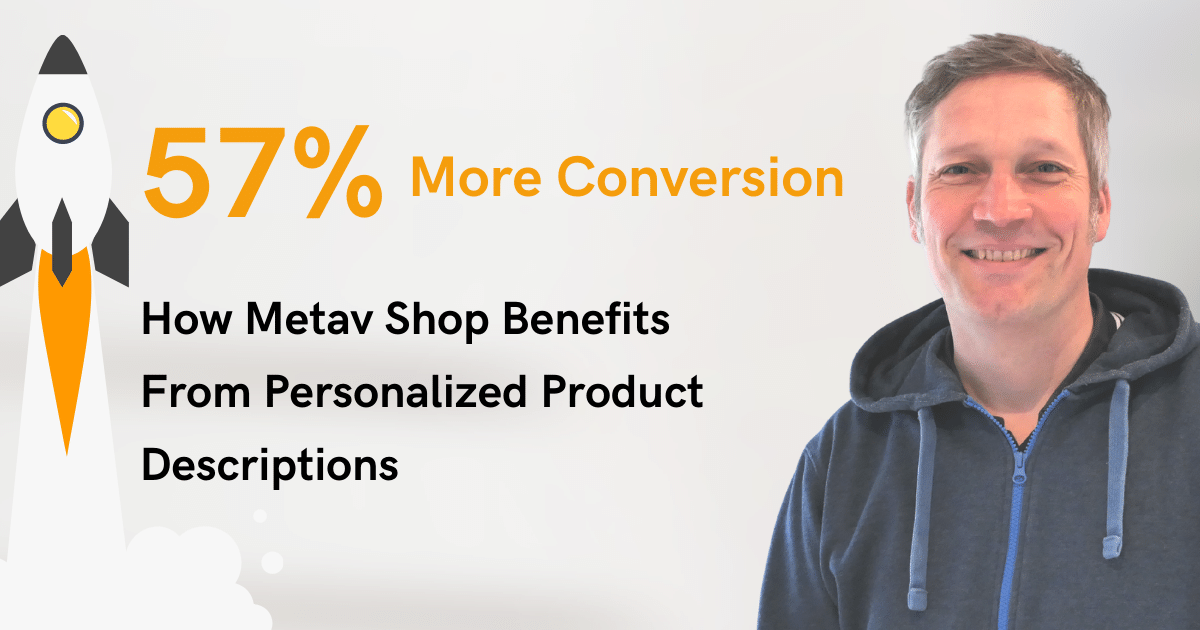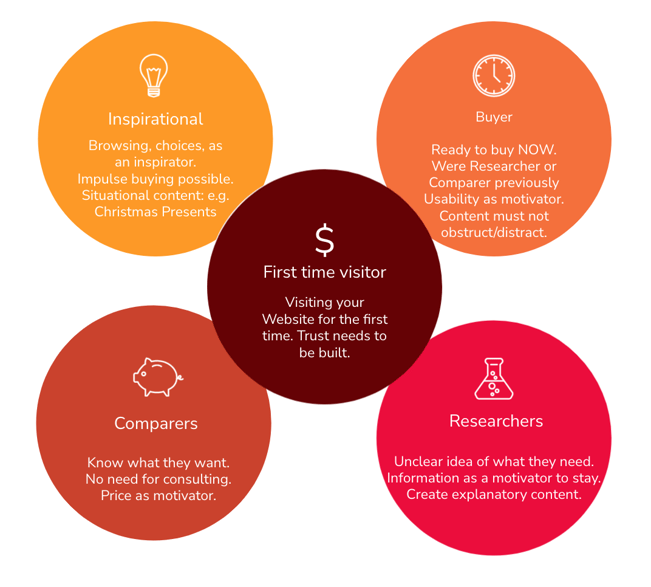E-Commerce | Customer Stories | Personalization
57 % Higher Conversion – Successful Usage of Personalized Product Descriptions
Reading Time 8 mins | November 11, 2021 | Written by: AX Semantics

Our belief is that personalization of product descriptions provides clear advantages for online stores. The results of Metav Werkzeuge GmbH has exceeded our expectations and forecasts.
In just one week, Metav Werkzeuge GmbH has implemented the AX product Personalized Commerce, which is the personalization of automated descriptions and the relevant dashboard into its store. After only one month, astounding changes are clearly visible:
In comparison to non-personalized content, the personalized descriptions convert with 57% more. The unpersonalized descriptions currently convert to an average of 4.9%, while the personalized product descriptions convert 7.7%. The conversion is determined by shopping card entries.

This is also a great success for Stephan Bayer, CEO at Metav Werkzeuge GmbH: "We have of course hoped to have higher results in the conversions through personalization, so the fact that there was already an increase of 57% in the number of shopping card entries for personalized descriptions has exceeded our expectations."
In addition, when personalized descriptions of the product are displayed as opposed to "plain" text, the online store records a 29% higher engagement rate on the product page. The engagement rate is an indication of how much the buyer interacts with the product description, perceives it and engages with it.
Honestly, though - these are figures after only one month. We are going to keep an eye on the development of things and report here regularly.
Why does Metav Werkzeuge personalize the product descriptions?
As an online store for very specific tools, the company relies on technology not only in its product range but also in all other aspects of its business. Like many online stores, the company is facing the challenge of presenting the products in the store in an appealing way and supporting the purchase with a relevant product description.
Stephan Bayer considers the highly technical, similar products that have very subtle differences to be a significant advantage in the online store. At the same time, though, this was the type of task that couldn’t be done adequately by his team of 4.
Metav started using the product description generator in the store at the beginning of the year. Together with the implementation of the product Personalized Commerce of AX Semantics, the company has personalized one of its first descriptions.
Personalized product descriptions for a strong customer relationship and more independence from the e-commerce giants?
Stephan Bayer is investing a lot of energy in the strategy of making a difference in the online store for its customers and prevailing against the big e-commerce giants, such as Amazon, eBay and Co.: “I strongly believe that our focus on speed and technology can recapture the customer relationship and thus make us more independent from the big e-commerce players. Therefore, in addition to natural language generation (nlg), I also see great potential for personalization of content.”
Why more independence, though? After all, online retail is booming? More than ever since Corona. What's the problem? Store operators know the flipside: Due to the massive acceleration of online commerce, e-commerce companies are increasingly having to compete for customers. Winning customers via the major platforms is becoming more expensive, and the price trend on the advertising market is even exceeding the good development in e-commerce. A glance at the figures:
At Amazon, the CPC (Cost per Click) went from 0.75$ in May 2020 to 1.20$ in May 2021. Winning customers became 60% more expensive on Amazon.
Facebook’s advertisement costs remain at a high level, although the efficiency of the campaigns have become significantly worse. Therefore, advertisers have to invest more.
At Google, CPC (cost per click) increased by 3% in the first quarter of 2021 compared to the same quarter of the previous year.
Apple’s data protection initiative, which makes data collection in apps harder, is causing a drop in sales among app providers. The USA has registered 15-20%.
How does a trust-building content for a better customer relationship look like?
There was this time in the stationary trade as a salesperson turned visitors into regular customers with their attention and advisory service. When purchasing running shoes with a long consultation talk ,a comprehensive foot analysis and at the end with free training tips. The purchase of a suit, electrical appliance and even when buying inexpensive goods such as screws or cleaning agents, you could ask your individual questions and get your answers sometimes with more and sometimes with less effort. This is how retailers created and maintained customer relationships.
Even to this day, it is incredibly difficult to reproduce this closeness to the customer in online retailing. The platform operators have managed to get really close to the users with their branding. They use technologies that bring them even closer to the customer and therefore also further control the relationship with the customer. The retailer pays the price.Retailers need to regain control of their customer relationships. The thought of doing this is not completely new. Yet, those in charge have lacked the technical capabilities to this day. After all, how are the trust-building content and advisory topics supposed to reach customers and prospects in the customer journey?
The personalization measures of current systems automate the approach to individual customer clusters, but are not capable of adjusting the text content to different customer groups. To do this, many text modules would have to be written manually - a considerable effort that retailers are understandably avoiding. This leads to the fact that in relation to usually well-optimized online stores, the PDP (Product detail pages) are significantly less optimized. A major deficit.
Automated content creation makes it possible to automatically adjust the content for many customers. New content is played out in context depending on the customer journey. Here's a little thought game:
You are browsing the pages of a bicycle store for the first time. Store operators must provide you with content that will increase trust in the store. However, today we obviously present content that only refers to the product on the PDP rather than to our relationship. An example: if we add statements about the experience or service quality of the bike provider to the product description: "We are one of the largest e-bike providers in Germany and dispose of a nationwide pick-up-and-delivery service." A good way to approach an important aspect for the customer relationship in the context of the product search.
Suppose you have an e-bike in your shopping cart and you visit the bike store again and read the PDP to make sure you have made the right decision. This time, the product description includes a note about possible product financing. Once again, with the automated content, the supplier invests in the customer relationship.
How has Metav Werkzeuge GmbH implemented this task?
Using Personalized Commerce of AX Semantics, Metav Werkzeuge successfully targeted customers in their individual context based on their different customer journey motivations. Metav can closely observe via a dashboard, how the interaction with the product description behaves and optimize it, if necessary.
The software distinguishes between 5 customer typologies, each at a different point in the customer journey and thus with different intentions:
The 5 Types in the Customer Journey
- First time visitor: The visitor who is new to the store and wants to trust it.
- Inspirational Type: The visitor who’s still searching and wants to be inspired.
- Researcher: The visitor who wants more information about the products, because he does not exactly have a clear idea what the products are all about.
- Comparer: The visitor who already knows what he wants, but still compares the details.
- Buyer: The visitor knows what he wants and has made the purchase decision.
Customers who first get inspired, for example, have a different need for information than those who have already made their purchase decision or those who compare products and retailers. The implementation of AX Semantics Personalized Commerce is quite simple: Online merchants simply embed a code snippet into their website, allowing them to identify individual customers based on their browsing behavior.

Example of a “First-Time Visitor” at Metav Werkzeuge GmbH:
If the embedded snippet detects that a visitor is on a product page for the first time, a corresponding suitable text will be displayed. This is aimed at winning the trust of the potential customer, as he may not even know the company yet.
Metav has decided in this case to point out the variety of products and the extensive warranty. The customer thus knows that he has encountered a retailer who knows his business and for whom the customer is king - this builds trust.
Example for the "buyer" (Buyer) at Metav Werkzeuge GmbH:
When a visitor repeatedly accesses the same page and has an item in his shopping cart for some time, the snippet recognizes it. The aim here is not to give any purchase-distracting information.
The possibilities are, of course, very individual, depending on the important message in the specific case. For example, if the item in the shopping cart is from the high-price segment, the indication of possible financing options can be displayed here in a targeted manner. This information can then cause the customer to actually decide to buy.
What happens next?
Metav Werkzeuge has implemented personalization in the product descriptions in the most efficient way possible. There are many possibilities and the descriptions can be further optimized. The company has already achieved great success with the "first quick version" of the personalized descriptions. It therefore remains exciting how the descriptions and numbers will develop in the store. We will stay on this case and regularly update the numbers in the blog. So stay tuned.
Stephan Bayer was also a guest at our Meetup and spoke about the implementation of the personalization option:
